Memories of Cotabato

Sagayan Dancers greet us at our arrival
From 2/17/23 to 3/4/23 I participated in TribuTur, a “hands on field study custom-designed for participants to explore, discover, and draw empowerment from indigenous Pilipino cultures of Mindanao.” The tour is conducted by the venerable SF arts organization Kularts and its visionary artistic director, Alleluia Panis. The following snippets are from the second leg of the journey after Tawi-Tawi. All of these stories are derived from daily letters to my spouse, Catherine, chronicling this unforgettable experience.
"One of these days I will take you back to Mindanao so we can play together in my hometown.” My kulintang teacher, Danongan Kalanduyan, with whom I studied for two decades, often expressed this sentiment during the latter half of the precious time we shared. After years of missed opportunities, Danny passed away in 2016. Failing to accompany him on a musical homecoming remains one of the biggest regrets of my life. I was apprehensive before our group’s journey to Cotabato, afraid of grief when I finally stepped foot near Danny’s place of origin, without him.But there was no time to dwell on loss as we were regaled with music and dance before we could even check into our lodging. The moment our vans pulled into the narrow street leading to our motel, Sagayan Dancers, those lithe festival warriors who twirl, shimmy, and leap with the tambor (marching drum) while shaking their beaded swords and shields appeared, colorful skirts of green, yellow, and red providing a graceful contrast to their athletic movements. It is customary to throw money at their feet, and I did so enthusiastically.
The award-winning Mamayug Sa Maguidanao kulintang ensemble also greeted us with spirited renditions of Binalig and Kangungudan, the more rhythmic “new” style of kulintang which can be played at supersonic speeds. They played differently from Danny’s way. Their melodic accents and sticking patterns had a Cotabato swing I had never heard before. When the band encouraged me to play, I was still able to identify the endings and stop at the same exact moment, but the melodic progressions felt fresh and unique. The tradition is so vibrant that Danny’s pieces felt like classic ‘70s or ‘80s tunes in comparison. Not only is the music I learned from but one lineage (Danny is from upriver, in Dulawan) within a sprawling genealogy, the entire tree itself has evolved.
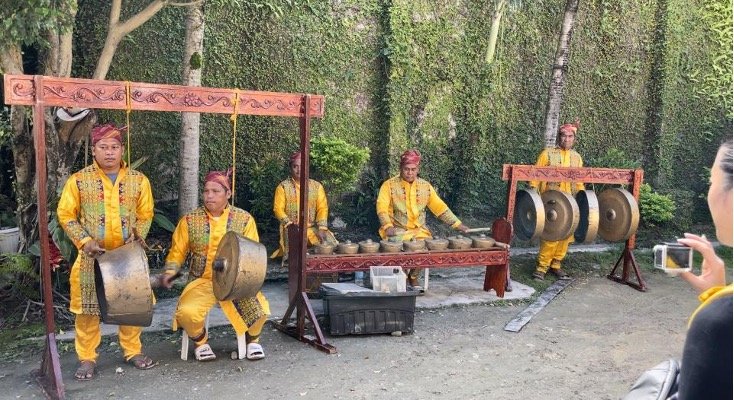
The award winning Mamayug Sa Maguindanao
Is there value in having “preserved” a specific kulintang sound and style brought to the U.S. decades ago? Yes. It continues to compel my heart and spirit. And it beautifully allowed me and fellow tour musicians to connect without words with our hosts. But I honestly think we could do more with the artistic traditions we are gifted with than just parroting what we learn. Filipino Americans are a distinct and diverse community too, with an ongoing history that is fertile soil for its own artistic traditions. I play and teach the hits Danny taught me with fidelity and love, but it is 2023 in America too, and our story on this land is deep and enduring enough to birth its own songs.
***
The Maguindanao people inhabit a flood plain nourished by great rivers, chief among them the Masla Pulangi (literally “Big River”). Indeed, that soil has grown a culture as rich and epic in its cosmology as any I have encountered in books. In Cotabato we encountered two mighty rivers of a different sort, that bring not water and sediment but song and dance, nourishing the landscape within: the storied Mohamad family and Salamindanao Dance Company led by the inimitable legend, Faisal Monal.

Salamindanao Dance Company
Down a side street in the heart of Cotabato, we called upon the Mohamad family. The slight drizzle did little to dampen the blazing conflagration of artistry that greeted us when we entered the small sheltered outdoor space outside their house, which serves as their rehearsal room. The family members are champion musicians and Sagayan dancers led by 85-year-old matriarch Kagi Kadiguia Mohamad, who literally yawned after electrifying us with multi-layered songs from the old, established style (kamamtuan) and new rhythmic style (kangungudan). She was equal to the gents from Mamayug Sa Maguindanao in technical brilliance but seemed to draw her notes from a deeper well. She was like a librarian, picking and choosing from a grand collection the books she wanted to read to us. The Sagayan dancers of the family are current and past champions who are the Roger Federers and Rafa Nadals of the current Sagayan scene.

The matriarch Kagi Kadiguia Mohamad-brilliant
After a brief communal celebration in which Kularts dancers donned and wielded the regalia of Sagayan while the musicians tried out the agong and the tambul, we all sat down and had a tearful exchange of appreciation. I said in Tagalog that their music and dance were as beautiful and enthralling as any being witnessed in the great concert halls of the world.
One of the daughters, a 12- year-old named Laika, is a rarity who performs the Sagayan warrior dance with great skill, even though traditionally only boys are allowed to do it. She became emotional as she was showered with praise for being a trailblazer. The Mohamads are so accomplished that they are able to afford Laika the opportunity to break barriers. They have earned the credibility to change tradition in this significant way.
In the U.S. I am a part of a kulintang family of sorts. All of Danny’s students have an instant connection when we meet. The familiar songs we play are portraits of our shared experiences, nostalgic family photographs. We play them and say “Here we are, together in this experience.” But our family is diasporic—loose, fragmented, holding on to memory in the throes of a fevered American Dream. Laika’s family is like the Pulangi—undammed and one with its headwaters and tributaries, celebrating the fullness of its inexhaustible outflow without apology.
Faisal Monal conducts the Mindanao State University’s Salamindanao Dance company in Cotabato. I don’t know who was more excited as we entered the dance studio, the young performers peeking out of the dressing room or the Kularts participants who knew that the very group so many troupes in the U.S. try to emulate was about to give us a special show.
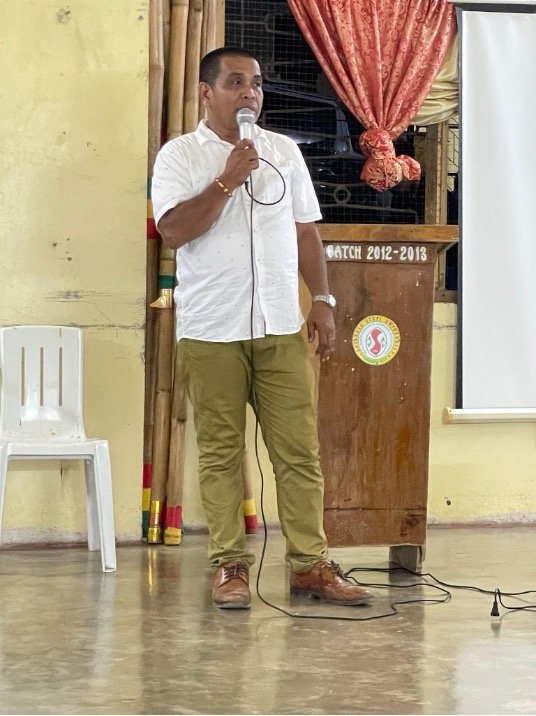
The inimitable Faisal Monal
After a brief slide presentation, the dances began. Faisal’s dancers were fantastic—poised, graceful, athletic, and conscious of the stories they were telling. They were giving of themselves even though they smiled during only one specific piece—a harvest dance echoing the planting and gathering of the fruits of the land.
Faisal provided an expert accompaniment on the kulintang. He is what educators would call a warm demander: a no-nonsense teacher who is able to push his students to give their utmost, while making them feel valued and safe. Faisal can be funny with his charges, even as they exhibit the exacting discipline he has instilled. The trust was evident in the expert execution students displayed. It was a heartwarming show of artistry, community power, and intergenerational legacy.
The Kularts participants also presented dances and poetry. Each of us had the opportunity to express what a thrill it was to share space with Salamindanao Dance Company. If those young artists did not know before, they are now fully aware of what they mean to cultural troupes in the United States for they are the Pulangi to those groups—a mighty and undisputed source.
***
Long before your eyes encounter a river, your body feels its pull. There is a subtle tug on your footsteps, in the same direction the trickles, rills, and roots are following beneath your feet, to where the lushness and noise of life are congregating. Like a meteorite falling into the Earth’s gravity well, your arrival at its banks feels inevitable.
Thus, my feet were drawn toward the Pulangi on the morning of the last ritual of the Ipat, a three-night indigenous healing ceremony made possible by Faisal Monal, whom I would describe, among many other things, as a bona fide lorist. The land still lay sleeping by the riverside when we arrived at dawn. Wisps of bright kulintang music wafted towards us from the ceremonial house like echoes from a timeless place.
I stole some time to touch my bare feet on the roots of a coconut tree I had visited during the previous nights and to watch the wind move through the grasses. Eventually, I made my way to the kulintang and when I was asked to play, I did so without the timidity I’d felt before. I played Danny’s Kaluntang and his Kapagonor as the sun peeked from behind the clouds. The warm rays felt good on my face. When I finished, one of the Ipat musicians started tapping the fast agong pattern for Tidtu. He asked with a sly smile “Kaya ba?” (Can you do it?) And I did. I played the song happily, having attained a feeling of confidence and belonging. Midway through the song, the Kularts participants began an impromptu dance around the outdoor ceremonial area, which was festooned with bright red and yellow banners. They gracefully wound their way around the food offerings and totems, joyous at being able to offer their artistry at the end of a grueling three-night spiritual journey. When Manai asked us to do it all again, it was like living a magical moment twice.
I played with mindful abandon during this Kularts prologue to the closing ritual. It was exhilarating. I didn’t feel my old teacher’s presence in any kind of supernatural way, but that morning was the closest I have ever felt to Danny again since he died. This was enough for me to speak to my grief. And after all, I play the songs he taught me every day—that is his spirit running through me too.
I lost my father during the Covid pandemic. I was terrified that this pain would well up uncontrollably during the Ipat ceremony too. (I already felt very tender in the days leading to the Ipat, gulping down sobs at every single evening debrief/sharing circle.) But it didn’t, thankfully. Did the Ipat allow me to heal from the pain of losing my real dad and my music dad? I’m not sure. But if my wife ever tells me I should go see a therapist I would, now.
***
Dance
The Ipat rituals were held inside a small house by the river, surrounded by muddy grassland dotted with coconut and talisay trees in the middle of an undeveloped section of Cotabato. The space was festooned with colorful fabrics—yellow, red, and pink with ruffles and intricate patterns in golden thread. On one side cloth “rooms” shaped like small hanging closets glowed; dwelling places for the spirits. Outside, kulintang musicians played tagunggo, the song to invite spirits, on and on until it became, like the incense, a part of the very air we breathed.
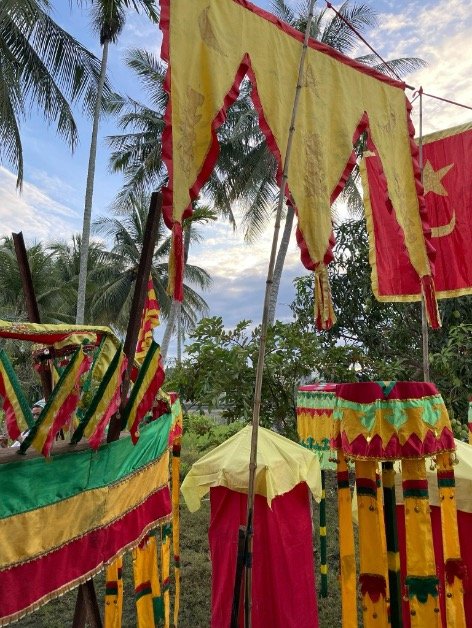
Outdoor Ipat regalia
In the middle of the candle-lit room—surrounded by large platters of turmeric rice, hard boiled eggs, stewed chicken and sweet rice cakes—was a model ship the size of a bathtub waving fourteen flags, each representing one of the ancient kingdoms.

Walking to the Ipat House at dawn
The first act was to pull this boat into the air and tie a ceremonial cloth evoking the sea and sky around its hull. Seeing the ship aloft in front of us transformed the feeling in the room—as if myth had now entered the space. The shaman, Den, who turned out to be quite a handsome fellow, laid down with his back to us as if to sleep.
Den’s arms began to shake and after a while he arose from the floor chanting in a feminine voice. A female spirit was now with us. They donned a blouse and a headscarf veiling the eyes. Still chanting, they approached each participant, anointing us with a fragrant oil. Their thumb vibrated as they pressed upon the top of my head.
The energy in the room began to intensify—we were fish, and the powerful timbre of the ritual gongs was the moving river we breathed, inexorably flowing to its destination. The participants began having intense emotional or spiritual responses as the ritualist and an assistant gently pulled them off the floor to dance. Some became tearful and others simply let go.
Although I did not experience the same catharsis, I was enthralled by the startling beauty of the ceremony. The androgyny of the ritualist was powerful to behold. The act of healing, essentially, was to rise, to reach out, hold hands with another soul, and dance. Such a tender act. It felt familiar, a reminder that the meeting of mind, body, and spirit is the natural tendency of the self.
The ritual ended with the shaman lying down again with their back to us, singing themself to sleep. When the music stopped, Den awoke bleary eyed as he took the veil from his face. Though it was still dark, I turned to the windows expecting to see daybreak. The feeling of being on the other side of something, of passing some threshold, was strong.
After, I went out into the night, pressed my bare feet on the roots of a nearby coconut tree and looked up, past the gently swaying fronds, at the stars. I wondered why we couldn’t have done that outside like when the Purple Woman made the celestial dome tilt around her. The night breeze offered no reply.

Walking to the Ipat house at night
***
At the end of each evening Ipat, it is customary to eat the blessed food offerings. It is also customary for the shaman to read fortunes based on the order in which a subject picks the different food items: turmeric rice, hardboiled egg, stewed chicken, and a glass of water. The trio who got their fortunes read was decided by a raffle. For the first two nights, I watched Den carefully study each person as they made their selections. Faisal, who I must say, kept announcing how tasty the chicken was, translated the shaman’s readings. It was a light bonus ending to each spiritually exacting evening. The excited discussions about how accurately Den seemed to have described dramas and storylines currently weaving through each subject's life provided great conversation the next day.
On the third and final night, I drew the last slot. At first I was excited about having my fortune read, but how many times had I encountered epic tales of woe that began with some wrinkled wisewoman/man making a prediction? Den was definitely not wrinkled—he had flawless skin—but still, I had no room in my life for whatever he might see, even if I did make sure to choose that chicken stew last. I hastily proffered up my paper for someone to take.
The beneficiary was extremely grateful, and I was commended for my generosity, but I knew the guilty truth: I did it to save my own hide. I held my breath as Faisal translated Den’s reading of the person, and was finally able to let it out when the fortune ended without a calamity. I would have felt so guilty, and probably would have had to come along if Den had invoked some risky quest involving pain and sacrifice. Sigh of relief.
***
When I was ten years old, I tried my hand at breeding fighting roosters. I had a retired champion fire-red rooster my uncle gave me along with some fierce native hens that fought like roosters too, and an abnormally big speckled white rooster I had high hopes for. I invested time into training that one and used to carry it around my old subdivision in Parañaque, challenging any rooster I spotted in a neighbor’s yard. We would tie little green gloves over the spurs and let the birds go fight. That big rooster of mine always ran away squawking after a few kicks to the chest. The breeding operation was also a disaster, even with the champion and the fierce hens. Their offspring were hot blooded and aggressive, yes, but severely undersized. Somehow, I had bred halfling chickens. One day, I came home from school and there was a big platter of perfectly golden fried chicken on the family dining table. My breeding program officially ended with garlic fried rice.
I learned how to handle chickens though, and became aware of the impending doom that lurked in a chicken’s life. So, when I saw four gasping forlorn fowls tangled up under a table heaped with rice cakes and fruit on the closing morning of the Ipat ceremony, I knew. I gently untangled each one, used my thumb to rub each of their feathery heads right where it meets the spine, and whispered words of encouragement.
“The Maguindanao people inhabit a flood plain nourished by great rivers, chief among them the Masla Pulangi (literally “Big River”). Indeed, that soil has grown a culture as rich and epic in its cosmology as any I have encountered in books."
When Den emerged from the house dressed as a real Sagayan Dancer, not a festival one, wielding a sword shaped like an undulating flame, the time had come. Imagine my surprise when a different set of chickens was sacrificed. In my haste to administer last rites to the ones beneath the table, I had completely missed a coop to the left of it, which held the actual martyrs. In all, seven birds were offered up, and by the last one, the droplets and desperate flapping and flopping around the ceremonial area had reduced many Kularts participants to tears. Alas, we could not expect to summon spirits from so far away that they needed a boat, have a beautiful healing ceremony, and not pay a price. The sobs that wracked those chests that morning were also coins.
Curiously, there were eight chickens in the end-times coop, and Den only dispatched seven. I looked at the last one and thought, what a lucky duck. Unfortunately, it was to be tied onto a not so buoyant ceremonial float being released into the river. It defied its Viking-like fate, however. Intrepidly eluding the hands of its collector, this feathered Houdini flapped off to the blessed branches of a nearby tree. When an assistant climbed to retrieve it, the plucky clucky fowl flew away into the tall grasses. The little children were conscripted and a noisy chase in and out of the lush greenery by the riverbank ensued. It was bedlam. The poor thing was eventually caught and as it drifted away along the path of the Pulangi, I waved in admiration.
I walked back to my friends still sitting under the shade of their table and congratulated them. They had some time yet to do chicken things. I hoped the bugs would be tasty and the grasses would fold neatly in the tiny little food sacks above their chicken breasts.
After, there were many other protocols. We had to dance/flee around the ceremonial area several times with the veiled shaman still wielding his sword right behind us. We each had to pour salt and freshwater into a small tub to symbolize the meeting of the mighty river and ocean. And Den had to hack in two an effigy representing all the negative energy expunged by the Ipat. This bad-vibes effigy made of bamboo and green reeds was man-shaped, complete with balls and penis.
The Ipat ceremony had all the symbology and tragedy of a proper ritual. Tied in very specific ways to the land, it reflected a cosmology that is ancient, epic, and in touch with the mysteries and banalities of the universe. Any spirit would have had to say, fondly, like that farmer in the movie, Babe, “That’ll do.”
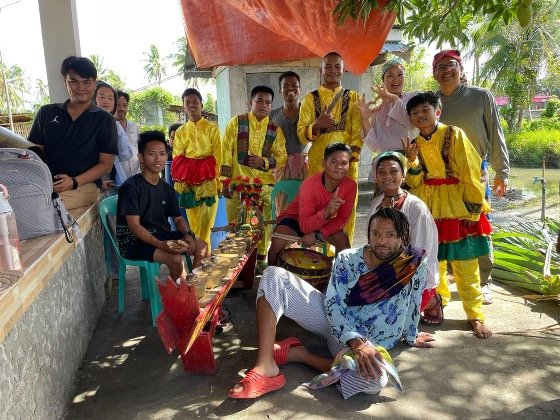
After Ipat photo
***
If you dislike the sour aftertaste in some coffees then the coffee in Mindanao is for you. The cups that I drank had a chocolate undertone that slowly made coffee a breakfast staple while I was there. I first tasted Mindanao coffee at Naida’s Cafeteria, a pleasant working-class eatery we frequented on Makakua Street in Cotabato. The menu items are inside a glass display case: fried fish, tortang talong (stuffed eggplant), string beans, fried chicken, and Naida’s famous pastil, which is sticky rice with shredded savory chicken wrapped in banana leaves. You point at what you like and then eat first before counting up all of your empty plates and walking up to a person behind a screen window to pay.
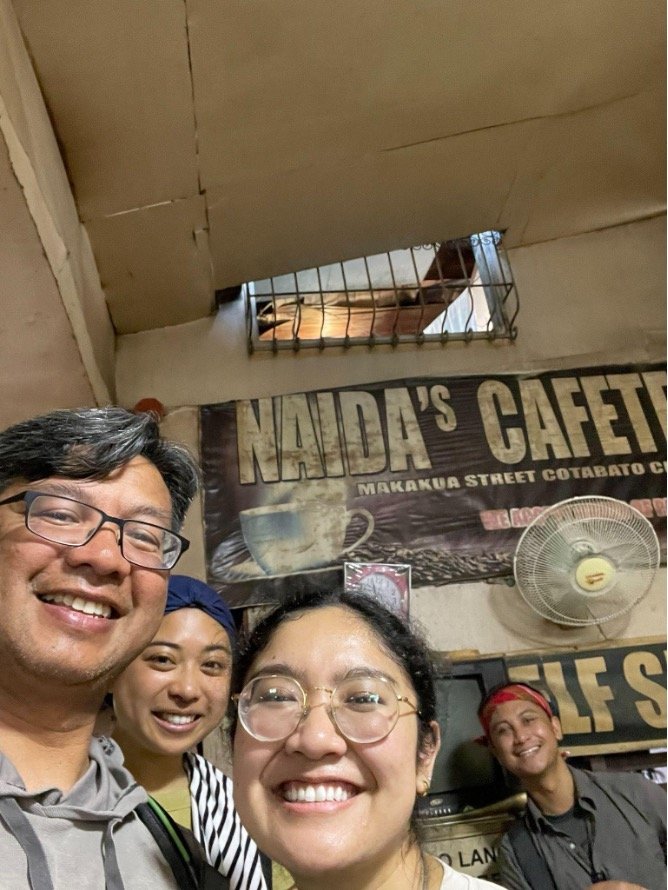
At Naida’s enjoying Cotabato style breakfast
Naida’s seating is communal, so one morning I was fortunate enough to have a pleasant conversation with three ladies. They told me about the Shariff Kabunsuan Festival in December, an annual fluvial parade commemorating the arrival of the person who introduced Islam to central Mindanao. They were an interesting trio -- one was no-nonsense, the other was very earnest about the parade, and the third asked many questions, such as what we ate for breakfast in the U.S., which necessitated the unfortunate description of dry cereal and nut milk. They all looked like veteran workers grabbing a meal before the day’s toil. When it was time to go, I offered to pay for their meal together with Jazzlyn who was also at the table. This drew a surprised smile from the no-nonsense one, which was nice.
After, we went to Kabuntalan to meet his royal highness, the Sultan of Kabuntalan. I wondered if the three ladies at Naida’s had ever laid eyes on him. We met the Sultan’s entire cabinet, including his secretary of war, which was a stern reminder that the cultural practices we had come to observe continue to thrive here only because their right to exist has been stoutly defended. This region is called BARMM, the Bangsamoro Autonomous Region in Muslim Mindanao, and it has had a complicated and often contentious relationship with the Philippines’ central government.
When the speeches were done, the Sultan allowed us to view the sacred objects of the sultanate no one is ever allowed to see. Even Faisal was awestruck as the items were arranged upon a table. There was a weathered metal scepter that looked suspiciously like a large wand, the fossilized remains of an ancient serpent wrapped in red cloth, which is said to sprout wings at night and fly, and finally a very ancient Quran written on crumbling leather parchment.

Everyone was excited to view the sacred artifacts of the Sultanate
As the minister of war attributed their military successes to the mystical power of these objects, I glanced at all the Kularts participants. If one of them was secretly an imperialist spy, this would surely have been the moment to reveal themselves and suddenly grab the objects before making off to the surrounding swamp. Luckily, there was no such villainous thug in our party.
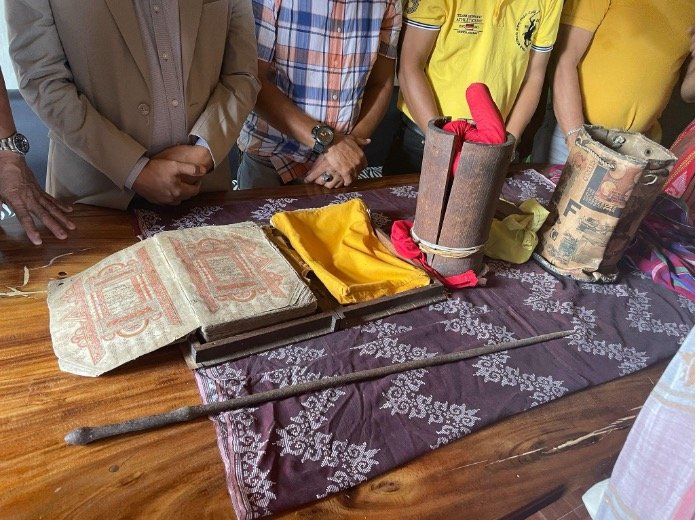
Imbued with powerful meaning
And so when we left Cotabato, it was still filled with everyday people just trying to get on, celebrating annual festivals, drinking coffee, and eating pastil in the mornings, upon a great flood plain, with their sacred ceremonies and secret objects of power, their myths and music, and mighty rivers, living a history that is storied, ongoing, self-determined, and free.

Conrad Benedicto is a teacher, author, and musician. His fantasy novel, Musalaya’s Gift, was published by Kularts in 2021 and the music of his band, Kulintang Dialect, is available on all streaming platforms courtesy of Gongs Away Music.
More from Conrad Benedicto

No comments